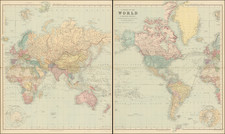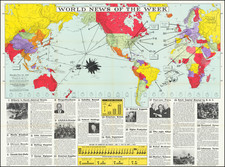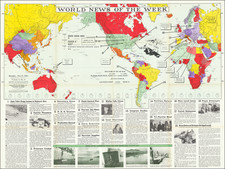The Known World in 1520 Through the Eyes of a Forger: Deciphering (a fake) 1520 Portolan Chart By Giovanni Battista Nero
The following description was done as if the portolan chart offered here was real. However, all evidence suggests that the chart is a 19th or early 20th Century object, created by a skilled forger.
The "Tabula Orbis de Fratris Joannis Baptista Nero de Porta de Genua Ann. Dñe 1520," a hand-drawn portolan chart on vellum, is a fascinating testament to the dawn of the Age of Discovery. Crafted by Genovese cartographer Giovanni Battista Nero, it captures the world as understood in 1520, a year before the discovery of the Straits of Magellan.
Extending from the Eastern coast of America to the China Sea and the Indian Ocean, the chart is a window into the nexus of the known and unknown world of that era.
One of the most striking aspects of the chart is what it excludes. It omits the Pacific Ocean, Western parts of America, northeastern parts of Asia, and any Arctic or Antarctic details, epitomizing the incomplete understanding of the world's geographical limits in the early 16th century. However, the inclusion of the Caspian Sea reveals the advanced knowledge of Eurasian geography that navigators and cartographers had developed by this time.
The artistic merit of the chart is also considerable, with the main illustration complemented by four miniature illuminations at its corners, each adding layers of meaning and context.
The first illumination depicts a saintly Jesus, donned in golden crown and robes, comforting Mary, with a naked body resting to their right, likely symbolizing death, resurrection, and divine comfort. The second miniature presents an anthropomorphized moon and sun on either side of the earth, which is illuminated on one side and dark on the other. This likely signifies the pre-Copernican, Judeo-Christian-centric view of the universe, with the earth at its center. The third miniature features four fish swimming in the sea, which may be an homage to the maritime orientation of the map and the era's exploratory zeal. Finally, the fourth illumination portrays an idyllic garden scene, with a lion, deer, and a small rabbit lying peacefully in front of three blooming trees. This image, reminiscent of the Garden of Eden, may symbolize a paradisiacal view of the newly discovered territories or an idealized vision of the natural world.
In Southern Africa, a 16-point compass rose dominates, with a windhead blowing northward from the southern Atlantic toward Europe. This compass rose reflects the directionality and navigational focus of the map. The depiction of four ships in the Atlantic and the Indian Ocean further cements the map's connection with the era's maritime exploration.
In terms of labeling, the North Atlantic Ocean is named "Mare Cogelatu," a term of uncertain origin. South America bears the labels "Mundus Novus" and "Brasil," reflecting the continent's recent "discovery" by Europeans and the Portuguese claim on the territory that is now Brazil.
Within the neatlines of the oval-shaped world, the names of the 12 winds are shown in Latin, reinforcing the navigational function of the chart.
In conclusion, Nero's "Tabula Orbis" is a remarkable artifact from the dawn of the Age of Discovery. It weaves together geographical knowledge, navigational tools, religious iconography, and naturalistic illustrations into a unique depiction of the world in 1520. Its intricate details and omissions eloquently testify to the interplay between exploration and understanding, highlighting the ever-evolving nature of human knowledge.
Conclusion
Overall, the piece stands as a thoroughly compelling contrafactum, an imitation or reproduction of another work. Its quality barely falls short when compared to the texture, style, and calligraphy characteristic of the late medieval / early renaissance period.
Rarity
Portolan forgeries appear occasionally on the market and are typically not difficult to detect.
Typically, the content, decorative images and structure of the rhumb lines are sufficient to demonstrate a forgery, but on occasion, when the forgery is a direct copy of an original portolan, other factors, such as transcription errors, typically exist.
Portolan charts are some of the most revered of cartographic objects, valued for their aesthetic, iconographic, and technical qualities. They are also historically significant, one of the first types of maritime charts and one of the earliest genres of regional mapping. Portolans developed in the medieval Mediterranean, but they combine elite and craft knowledge from Arab, Byzantine, Western Asian, as well as European navigational and mapping traditions. As Sonja Brentjes explains, “medieval adorned portolan charts are highly complex, polyglot cultural products that bespeak the creativity of their makers and the curiosity of their users, as well as the complexities of cultural interaction in the Mediterranean.”
The modern charts in use today find their lineage in Mediterranean portolan charts. However, earlier charts are known in Chinese and Arab contexts. Additionally, the development of the chart was not a foregone conclusion. Charts are first recorded at the conjunction of several world historical trends, including the expansion of trade over wider maritime networks, and at the conjunction of several navigational technologies, including the written sailing direction, or rutter, and the use of the magnetic compass, originally invented in China. The earliest known list of ports and coastal features, a periplus, was used by the Greeks, with an example surviving from the fourth century CE. These textual sailing directions are known to have existed alongside visual aids in the Mediterranean from at least the thirteenth century CE.
The word portolan developed from the Italian word for sailing directions, portolano or portulano, again underlining the close connection between different types of navigational tools. The first surviving portolan chart dates to ca. 1290. The Carte Pisane, probably made in Genoa and held at the Bibliotheque Nationale in Paris, depicts the Mediterranean Sea, as do many portolan charts. While the earliest example of a navigational chart to survive, it is certainly not the first of its type, as its striking accuracy and defined features attest. The development of the portolan chart before the Carte Pisane, that is, before we have reliable sources, is still a hotly contested academic debate.
Portolan charts typically consist of ink on vellum, made of calfskin, or parchment, usually goatskin. Vellum and calfskin are durable, an important attribute for objects that were to be used in the trying conditions of a ship at sea. Additionally, vellum and parchment can be corrected by scraping off a layer of ink and replacing it with new words or images, which was useful for correcting changeable navigational information. While many portolans were made to be used at sea, those that survive are usually those that were intended for an easier life on land, as luxurious presentation items, decorations, or instructional aids. Those that saw service at sea seldom survived the ordeal to enter the historical record, but other sources mention their use aboard ships.
Portolan charts share a set of conventions that would become standard for later nautical charts. They usually include a scale bar, although the unit of measure differed depending on its place of production. Important port names were written in red, while others were listed in black. These were written at right angles to the shore, and were written inland, so as not to obscure the coastline. Black dots or a cross were used to indicate rocks, while red dots indicated sandy shallows or a sandbar. Inland areas were usually devoid of geographic content, but could be filled with decoration and imagery indicating the ruler and religion prevalent in each place, not to mention local animals, plants, and other details.
Another defining feature of portolan charts are the rhumb lines, or loxodromes, that crisscross their surfaces. Rhumb lines are lines of consistent bearing. Originally, they were based on wind roses of 16 or 32 directions. The main winds would be indicated in black (or sometimes red), half winds in green, and quarter winds in red. Scholars have shown that this matrix of lines was laid down first, followed by the coasts and names, indicating that these charts were intended as instruments to find direction and bearing, not just as representations of space. Later portolan charts have the rhumb lines join at compass roses, which use cardinal and ordinal directions.
Many surviving portolans show the Mediterranean coastline, but others also depict the Black Sea, the Atlantic Coast of Europe and West Africa, the Indian Ocean, and other maritime spaces. While primarily meant to communicate nautical details, they also integrate larger geographic ideas such as the re-popularization of Ptolemy in the Renaissance. Their zenith was in the fourteenth and fifteenth centuries, but they continued to be made up to roughly 1700. The main early centers of production were Genoa, Venice, and, later, Catalonia, with important hubs in Mallorca and Sicily.










![[Mussolini Celebrates Pearl Harbor] Grande Carta Del Pacifico](https://storage.googleapis.com/raremaps/img/small/65273.jpg)
![[The centre of this Slider is to be placed by a Thread or Pin over the centre of the respective Planisphere for any Operation]](https://storage.googleapis.com/raremaps/img/small/65557.jpg)

![Typus orbis descriptione Ptolemaei [Verso title]](https://storage.googleapis.com/raremaps/img/small/103829.jpg)
